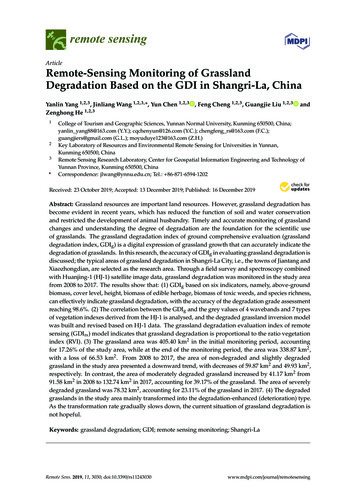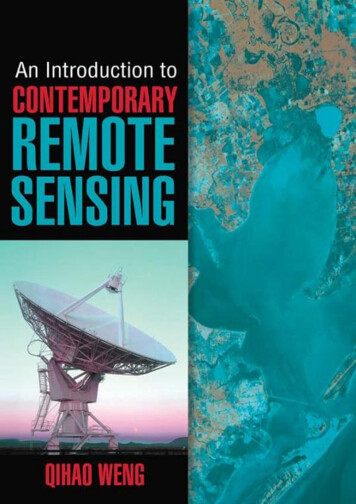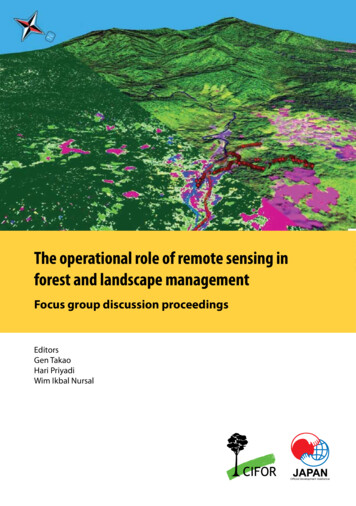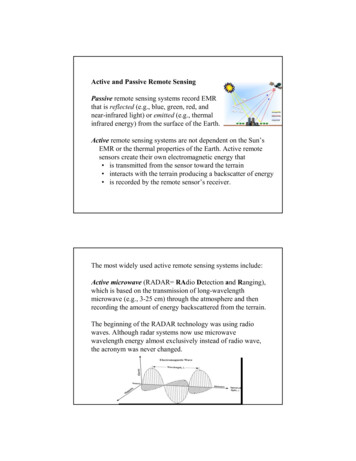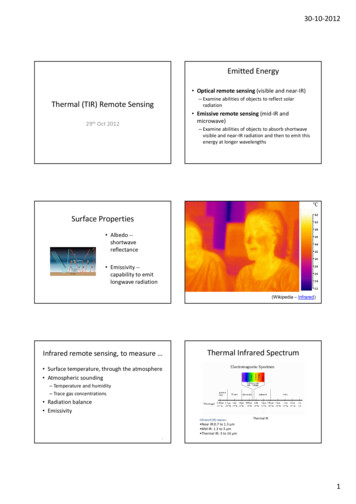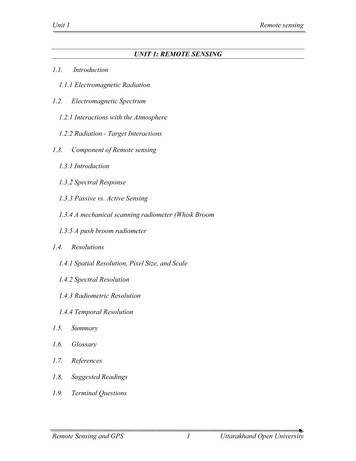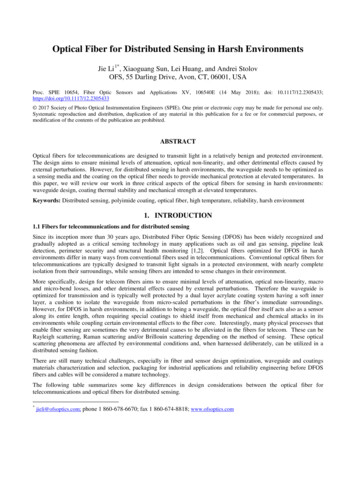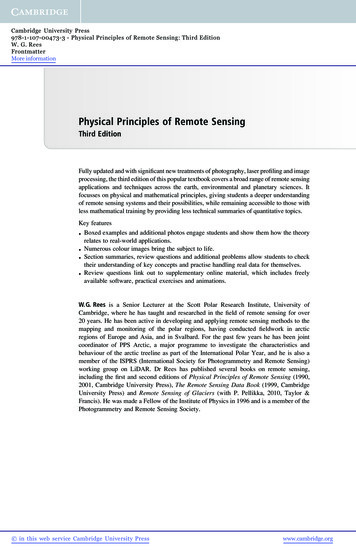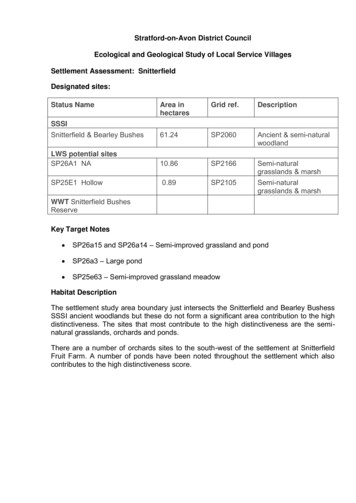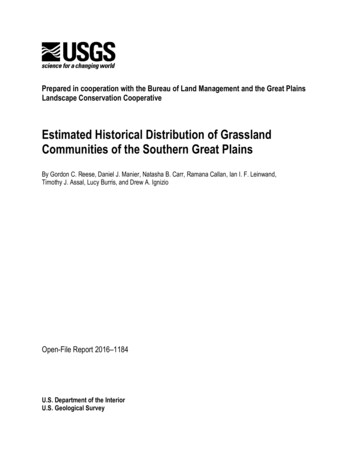
Transcription
Sensing – New Insights into Grassland Scienceand PracticeEdited byT. AstorI. DzeneVolume 26Grassland Science in EuropeI
Sensing – New Insights into Grassland Scienceand PracticeGrassland Science in Europe, Vol. 26 – Sensing – New Insights into Grassland Science and PracticeII
Sensing – New Insights into Grassland Scienceand PracticeProceedings of the 21st Symposium of theEuropean Grassland FederationOnlineHosted by Universität Kassel, Germany17-19 May 2021Edited byT. AstorI. DzeneGrassland Science in Europe, Vol. 26 – Sensing – New Insights into Grassland Science and PracticeIII
Published byThe Organising Committee of the 21st Symposium of the European Grassland Federation,Universität Kassel, Grassland Science and Renewable Plant Resources,Steinstrasse 19, 37213 Witzenhausen, GermanyCopyright 2021All rights reserved. Nothing from this publication may be reproduced, stored in computerised systemsor published in any form or any manner, including electronic, mechanical, reprographic or photographic,without prior written permission from the publisher.The individual contributions in this publication and any liabilities arising from them remain theresponsibility of the authors.e-book ISBN: 978-3-00-068789-1Abstract submission and evaluation byEditing and production byUniversität Kassel,Grassland Science and Renewable Plant ResourcesSteinstrasse 19,37213 tributed byEuropean Grassland Federation EGFW. Kessler, Federation Secretaryc/o AgroscopeReckenholzstrasse 1918046 Zurich, SwitzerlandE-mail: fedsecretary@europeangrassland.orgGrassland Science in Europe, Vol. 26 – Sensing – New Insights into Grassland Science and PracticeIV
Organising InstitutionUniversität Kassel,Grassland Science and Renewable Plant ResourcesSteinstrasse 19,37213 Witzenhausen, GermanyOrganising CommitteePresident andGeneral Secretary:Michael WachendorfUniversität KasselThomas AstorIlze DzeneThomas FrickeAndrea GerkeKatja HöckUniversität KasselUniversität KasselUniversität KasselUniversität KasselUniversität KasselChairperson:Michael WachendorfUniversität KasselMembers:Johannes IsselsteinManuel SchneiderDavid ParsonsThomas AstorGeorg-August-Universität GöttingenAgroscopeSwedish University of Agricultural SciencesUniversität KasselMembers:Scientific CommitteeGrassland Science in Europe, Vol. 26 – Sensing – New Insights into Grassland Science and PracticeV
ReviewersGeorg BarethGianni BelocchiJérôme BindelleCamilla DibariUta DickhöferPilar Fernández-RebolloJakob GeipelRené GislumStuart GreenNyncke J. HoekstraDirk HoffmeisterLucie HomolovaOlivier Huguenin-ElieChristoph HüttBernadette JulierLammert KooistraUlrike LussemJulien MorelGiovanni PeratonerMaria Pilar MartínAndreas SchaumbergerRene SchilsHélène SoyeurtSimon TaugourdeauBettina TonnAgnes Van den Pol-Van DasselaarMichael WachendorfJayan WijesinghaProof readerAlan HopkinsSponsors and supportersUniversität KasselStapledon Memorial TrustGrassland Science in Europe, Vol. 26 – Sensing – New Insights into Grassland Science and PracticeVI
ForewordThe 21st symposium of the European Grassland Federation is hosted by Germany. Twenty-five yearsago the Universities of Göttingen and Kassel jointly hosted an EGF symposium on the topic of OrganicGrassland Farming. During the past quarter-century grassland science and management have changedgreatly. In the search for more sustainable grassland production, research has generated an immensebody of knowledge on all aspects of this complex soil-plant-animal system. New technologies haveemerged, providing detailed information on a variety of grassland traits; for instance, biomass, qualityand botanical composition. Remotely sensed information was barely available 25 years ago. Only duringthe last 5 to 10 years have platforms, sensors and algorithms become widely available and with sufficienttemporal and spatial resolutions relevant for applications to practical grassland farming.This aims of this symposium are to bring together the existing knowledge in this relatively new field ofresearch, to feature upcoming innovations, and to identify existing limitations and challenges. A majorgoal is to contribute to bridging the gap between the complex and research-intensive technologicalprocesses, and the demands for feasible approaches in practical grassland farming. The meeting hasthree themes: (1) Biomass and quality characteristics; (2) Biodiversity and other ecosystem services;(3) Management and decision support. Sensing tools and methods assisting management and decisionsupport in grazing and cutting regimes are introduced and evaluated in plenary and poster sessions.They cover all levels of grassland intensity: from intensive grazing systems to grasslands for natureconservation purposes.The Covid-19 pandemic has presented an additional challenge for our symposium. We decided earlyon to move from a meeting in physical presence to an online-based meeting, which made it possible todevelop the web-based platform with the utmost care and to design it as close as possible to a face-toface conference.We would like to thank all the authors for submitting such a broad range of interesting papers. We aregrateful to all the reviewers and editors for providing constructive feedback. Finally, we would like toexpress our gratitude to all members of the local organising committee, the scientific committee, and toall the innumerable helpers for making this exciting symposium possible.Despite the difficulties caused by the Covid-19 pandemic, we wish that the EGF symposium will providenovel insights for grassland science and management and stimulate fruitful discussions and networking.Michael WachendorfChair of the organising committeeGrassland Science in Europe, Vol. 26 – Sensing – New Insights into Grassland Science and PracticeVII
Table of ContentsForewordIntroductionInvitedTowards an informed grassland farming – Shortfalls and perspectivesVII122Isselstein J.Towards an informed grassland farming – Sensors, platforms and algorithms11Bareth G.Theme 1. Biomass and quality characteristics21Invited22Drone-based remote sensing of sward structure and biomass for precision grazing:state of the art and future challenges22Bindelle J., Da Silva Neto G.F., Kokah Essomandan U., Carvalho P.C.F. and Michez A.Remote sensing for grassland quality assessment: Status and Prospects30Astor T. and Geipel J.SubmittedEstimating biomass yield and growth response to temperature in red clover using terrestriallaser scanning3535Kronenberg L., Srirangaraj J., Kirchgessner N., Knorst V., Grieder C., Walter A., Studer B. andKölliker R.Using commercial field spectrometers for estimating digestibility of grasslands: an examplewith the Yara-N sensor38Morel J., Zhou Z. and Parsons D.Evaluation of remote sensing vegetation indices to estimate forage yield and quality ofdifferent fertilized grassland41Schaumberger A., Klingler A. and Schweiger M.Information on yield proportion of grasses slightly improves the estimate of dry matter yieldbased on LAI44Peratoner G., Mairhofer F., Zwack B. and Matteazzi A.Potential of Sentinel-2 and optimal hyperspectral configuration to assess forage quality inpermanent grasslands of open woodlands; preliminary results47Fernández-Habas J., Leal-Murillo J.R., Hidalgo-Fernández M.T., Gómez-Giráldez P.J.,González-Dugo M.P., Milazzo F. and Fernández-Rebollo P.PostersRemote sensing-based estimation of nitrogen fixation in organically managed legume-grassmixtures5050Astor T., Grüner E. and Wachendorf M.Monitoring rangeland biomass during wet and dry seasons from a video obtained with asimple digital camera53Diedhiou A., Diatta O., Ndiaye O., Bossoukpe M., Ngom D., Julien L., Toure I., Diouf A. A., Bayet T.,Cambier C., Faye E. and Taugourdeau S.Detection of grassland mowing events with optical satellite time series data56Reinermann S., Asam S., Gessner U., Schucknecht A. and Kuenzer C.Generalizability of multi- versus single-target regression for herbage mass and qualityprediction from multispectral imagery59Simmler M., Hart L. and Liebisch F.Grassland Science in Europe, Vol. 26 – Sensing – New Insights into Grassland Science and PracticeVIII
From the field to the region – monitoring pre-Alpine grassland characteristics at differentspatial scales62Schucknecht A., Seo B., Reinermann S., Krämer A., Asam S., Atzberger C. and Kiese R.UAV to measure canopy height and plot biomass in a lucerne variety trial65Surault F., Roy E., Mahieu S., Combes D., Ghesquière M. and Julier B.Using UAV-borne imagery for plant height measurements of perennial forage species byphotogrammetry68Roy E., Mahieu S., Surault F., Combes D., Louarn G., Frak E. and Ghesquière M.Estimating grassland biomass using multispectral UAV imagery, DTM and a random forestalgorithm71Sutter M., Aebischer P. and Reidy B.Remote sensing data fusion and feature selection for biomass prediction in extensivegrasslands invaded by Lupinus polyphyllus74Schulze-Brüninghoff D., Astor T. and Wachendorf M.Using polygon grids to upscale ultra-high resolution UAV data for monitoring pastures77Bareth G. and Hütt C.Use of Sentinel-2 images for biomass assessment in extensive pastures in the Apennines(Central Italy)80Bellini E., Argenti G., Moriondo M., Staglianò N., Pugliese C., Confessore A., Aquilani C.,Nannucci L., Bozzi R. and Dibari C.A tool to select the best parental genotypes by combining lab and field tests83Statkevičiūtė G., Kemešytė V., Aleliūnas A. and Jaškūnė K.Estimating standing biomass of sown biodiverse pastures using a combination of remotesensing and machine learning86Morais T.G., Jongen M., Rodrigues N.R., Gama I., Domingos T. and Teixeira R.F.M.Predicting herbage yield in perennial ryegrass breeding trials using UAV derived data andmachine learning89Pranga J., Borra-Serrano I., Aper J., Ghesquiere A., Roldán-Ruiz I., Janssens I., Ruysschaert G.and Lootens P.Evaluation of a grassland drought index based on LAI from remote sensing andmeteorological data92Peratoner G., Greifeneder F., Castelli M., Crespi A., Zellner P.J., Vianello A., Morlacchi M.,Pasolli L., Bartkowiak P., Notarnicola C., Monsorno R. and Zebisch M.Validation of a workflow based on Sentinel-2, Sentinel-1 and meteorological datapredicting biomass on pastures95Nickmilder C., Tedde A., Dufrasne I., Lessire F., Tychon B., Curnel Y., Bindelle J. and Soyeurt H.Case study on monitoring sward height and available biomass with a rising plate meter onpastures of dairy farms in Southwest Germany98Werner J., Stumpe C., Höhn D., Bateki C. and Dickhöfer U.Influence of microplastics on the leaf temperatures of ryegrass101Cornelsen H. and Wrage-Mönnig N.The potential of unmanned aerial vehicle (UAV)-based multispectral data to estimate freshgrass allowance104Klootwijk C. W., de Boer I. J. M., van den Pol-van Dasselaar A., Holshof G., Fraval S. andvan Middelaar C. E.Grass quality measurement with a handheld NIR sensor107Bussink D.W., Sarjant S., Thijssen D. and Luleva M.Grassland Science in Europe, Vol. 26 – Sensing – New Insights into Grassland Science and PracticeIX
Theme 2. Biodiversity and other ecosystem services110Invited111Remotely sensed insights into grassland biodiversity111Rocchini D.Grassland vegetation monitoring: scale is important115Marcinkowska-Ochtyra A. and Kupková L.SubmittedDetection of mowing events from combined Sentinel-1, Sentinel-2, and Landsat 8 time serieswith machine learning123123Lobert F., Holtgrave A.-K., Schwieder M., Pause M., Gocht A., Vogt J. and Erasmi S.Using yellowness in drone-based RGB images to map buttercup cover in an upland pasture126Schneider M.K. and Willems H.Mapping invasive Lupinus polyphyllus Lindl. in grasslands from UAV-borne remote sensingimages129Wijesingha J., Astor T., Schulze-Brüninghoff D. and Wachendorf M.Using image analysis and machine learning to estimate sward clover content132Hennessy D., Saad M., Mac Namee B., O'Connor N.E., McGuinness K., Albert P., Narayanan B.,Fitzpatrick E. and O’Connor A.H.First results of applying UAV laser scanning to a cattle grazing experiment135Hütt C., Bolten A., Hohlmann B., Komainda M., Lussem U., Isselstein J. and Bareth G.PostersAssessment of rangeland condition in a dryland system using UAV-based multispectralimagery138138Amputu V., Tielbörger K. and Knox N.Permanent grassland established on eroded soils: floristic composition of different sectionsof a hillside after 27 years of sward naturalization following sowing141Matyziute V. and Skuodiene R.Initial evaluation of PlanetScope nanosatellite images applicability for identification ofgrazed plant communities144Radkowski A., Radkowska I., Drzewiecki W., Pirowski T. and Szewczyk W.Wide-area monitoring of soil moisture in peatlands using Sentinel-1 images147Yang C-H., Mader S., Müller S., Haub C., Müterthies A. and Herrmann A.European Monitoring of Biodiversity in Agricultural Landscapes (EMBAL)150Lindemann D., Oppermann R., Sutcliffe L., Moser D. and Haub C.Lifting the secrets of pastures: Overview of animal-borne sensors to uncover processesunobserved by classical grassland research153Pauler C. M. and Schneider M. K.Springtime grazing for meadowbird conservation156Hoekstra N.J., de Wit J. and van Eekeren N.Effects of innovative management options on perennial grassland in the mountain area ofSwitzerland159Mack G., El Benni N., Tindale S., Hunter E., Newell Price P. and Frewer L.Mapping grassland management and habitats with satellite and ground level imagerythrough machine learning163O’Hara R., Saad M., Zimmermann J., Green S., Finn J., Mac Namee B., McGuinness K. andO’Connor N.Grassland Science in Europe, Vol. 26 – Sensing – New Insights into Grassland Science and PracticeX
Theme 3. Management and decision support166Invited167The role of remote sensing in practical grassland farming167Green S., O’Hara R. and Zimmermann J.SubmittedA novel dynamic model for estimating standing biomass and nitrogen content in grasscrops harvested for silage production172172Hjelkrem A. G. R., Geipel J., Bakken A. K. and Korsaeth A.Movement behaviour of cattle analysed with GPS data as affected by three differentgrazing intensities175Hamidi D., Komainda M., Tonn B., Harbers J., Grinnell N. A. and Isselstein J.Detection of Senecio jacobaea in drone images, using a machine-learning approach178Petrich L., Stoll A. and Schmidt V.The effect of virtual fencing technology on grazing behaviour: differences in herbageconsumption181Grinnell N. A., Hamidi D., Horn J., Riesch F., Komainda M., Ammer S., Traulsen I. and Isselstein J.Monitoring of water content in legume seed production after crop desiccation usingmultispectral UAV images184Gaier L., Klingler A., Schaumberger A. and Krautzer B.PostersTraining cattle with virtual fences on permanent pastures187187Hamidi D., Grinnell N. A., Horn J., Riesch F., Komainda M., Ammer S., Traulsen I. and Isselstein J.Assessing feed efficiency in grazing dairy cows through infrared thermography andbehaviour sensors190Haak T., Münger A., Südekum K.-H. and Schori F.Automated detection of grazing behaviour with a collar-based monitoring system193Schmeling L., Thurner S., Nicklas D., Erhard M. and Rauch E.Using LiDAR derived Digital Terrain Models and field data to quantify riverbank erosionand nutrient loading rates196Hayes E., Higgins S., Geris J. and Mullan D.Using GPS sensors to estimate automatically the time dairy cows spend on pasture199Fischer A., Charpentier C., Lonis W., Philibert A., Allain C. and Lebreton A.Use of drones with infrared cameras to search for fawns before mowing – experiences frompractice202Mačuhová J., Wiesel T. and Thurner S.Testing the validity of a precision dairy ear sensor technology in recording grazing time205Grinnell N. A., Hamidi D., Riesch F., Horn J., Komainda M., Ammer S., Traulsen I. and Isselstein J.Identifying areas of homogeneous grassland management based on iterative segmentationof Sentinel-1 and Sentinel-2 data208Wesemeyer M., Schwieder M., Pickert J. and Hostert P.Estimating grassland biomass from Sentinel 2 – a study on model transferability211Buddeberg M., Schwieder M., Orthofer A., Kowalski K., Pfoch K., Hostert P. and Bach H.Tools for information to farmers on grasslands yields under stressed conditions to supportmanagement practices – the GrasSAT project214Dąbrowska-Zielińska K., Goliński P., Jørgensen M., Davids C. and Persson T.Accuracy improvement of Rising Plate Meter measurements to support managementdecisions in the Black Forest region217Stumpe C., Werner J. and Böttinger S.Grassland Science in Europe, Vol. 26 – Sensing – New Insights into Grassland Science and PracticeXI
Botanical composition and progress of the growing season affect assessments of herbageyield based on compressed sward height220Peratoner G., Mittermair P. and Mairhofer F.Development of a digital tool adapted to pasture management in South-West Germany223Krug P., Weber J. F. and Elsäßer M.IndexesKeyword indexAuthor indexGrassland Science in Europe, Vol. 26 – Sensing – New Insights into Grassland Science and Practice226227229XII
IntroductionGrassland Science in Europe, Vol. 26 – Sensing – New Insights into Grassland Science and Practice1
InvitedTowards an informed grassland farming – Shortfalls and perspectivesIsselstein J.University of Göttingen, Department of Crop Sciences, Grassland Science, Von-Siebold-Str. 8, D-37075Göttingen, GermanyAbstractGrassland in Europe provides a wide range of ecosystem services. However, the extent to which theseservices are provided often falls short of the expectations of agriculture and society. On the one hand,the provisioning potential of individual ecosystem services is not fully exploited, on the other hand, thereare strong trade-offs between different ecosystem services. One reason for unsatisfactory performanceis the lack of knowledge and information on functional relationships between management measuresand ecosystem function targets. As a result, management decisions are not sufficiently targeted. Newtechnological developments in smart farming in the field of sensor technology and informationprocessing open up a wide range of possibilities for obtaining data to document biological productionprocesses with a high temporal and spatial resolution. The information can be used to rationalizeproduction processes and reduce trade-offs between different services. This paper examines theweaknesses of current grassland management practices, provides a summary of technologicalinnovations, and analyses their potential applications using pasture management as an example.Keywords: smart grassland farming, technological innovations, livestock grazing, ecosystem services,managing trade-offsIntroductionPermanent and temporary grasslands cover some 40% of the agriculturally utilized area in Europe.Grassland systems are a major contributor to the food sector. They enable the keeping of grazinglivestock, which account for about 60% of all agricultural livestock in Europe. These livestock provides6about 25% of the food energy of the human diet (Huyghe et al., 2014). The grassland-based productionof food thus represents an important area of the bioeconomy of the entire national economy. In thebioeconomy it is important that biological production processes can be precisely managed andcontrolled. Only then can the goals pursued with the production process be precisely achieved. Thisworks well with production processes that take place under largely or completely controlled conditions.These include, for example, the horticultural production of vegetables and fruit in greenhouses or theproduction of processed products with the help of microorganisms, such as yoghurt and cheese, orfermented beverages. The better the chemical and biological (scientific) fundamentals of the productionprocesses are understood, the more effectively the production process can be designed. What is truefor industrial biological processes is in principle also true for agriculture and especially for grasslandfarming. However, grassland farming differs from industrial bioeconomy business. Grassland systemsare more complex. On the one hand, they are closer to nature and thus more dependent onenvironmental factors that can hardly be controlled. On the other hand, there are more products/servicesbeing produced, not only the livestock produce. Rather, diverse services are provided, each of whichcan be highly variable within the category. This applies to food as well as to environmental services. Inaddition, many sequential production steps are required and different components are involved. Agrassland-based production system includes the soil-dependent production of fodder and the livestockproduction that converts the fodder into high-quality food. Controlling such a production system isobviously difficult. Rational management decisions require that the effects of these decisions can bepredicted as precisely as possible. Practical experience plays an important role here, but theconsiderable progress in production in recent decades has been achieved through scientific knowledgeabout the principles of production processes (see Caradus, 2006; Lemaire et al., 2005). Despite theseadvances in grassland farming, production processes are not optimized, the forage production potentialof a site is not achieved and the efficiency of conversion of plant energy into livestock energy isunsatisfactory (Huson et al., 2020; McConnell et al., 2020). In addition, there are major uncertaintieswith regard to the provision of environmental services. This is obviously due to a lack of information oraccessibility of information for stakeholders. The aim of the present paper is to analyse (i) to what extentGrassland Science in Europe, Vol. 26 – Sensing – New Insights into Grassland Science and Practice2
there is a lack of accessible information for rational grassland management in the farming practice, (ii)which areas of grassland management are particularly affected by this, (iii) which technologicaldevelopments could remedy the information deficit, and (iv) how technological developments can beapplied successfully in production processes.Challenges for grassland farmingGrasslands in Europe are extremely diverse and they support a variety of important ecosystem servicesapart from milk and meat (Peeters and Isselstein, 2019). The vast majority of European grasslands areman-made habitats. Their diversity is a result of a broad range of different site and environmentalconditions interacting with a large variety of farming measures (Dengler, 2014; Poschlod, 2017). Acontinuous management is thus required to maintain the diversity of ecosystem services. The provisionof such a diversity of ecosystem services has been summarized by the term 'multifunction grassland'and this term has received increasing attention in science, and also in society and politics in recentdecades (e.g. Lemaire et al., 2005, Isselstein and Kayser, 2014; Huguenin-Elie et al., 2018). Theconceptual idea behind the term multifunction grassland is that different grassland managementobjectives can be achieved simultaneously. A single objective should not be given priority at the expenseof one or more other objectives. For decades, however, this was the case. Production goals wereexpanded at the expense of the environment. In many cases, grassland farming was intensified in orderto produce more fodder per hectare and to achieve higher livestock yields. This provokedenvironmentally harmful emissions and reduced biodiversity.Table 1. Simplified representation of the site and management conditions under which high or maximumperformance is achieved for the various ecosystem services (own compilation).EcosystemserviceFood: producefeed and foodNature:protect andpromotebiodiversityClimate: reducegreenhouse gasemissions, sequestercarbonWater: providesufficient andclean ile, wellsupplied withbasic nutrientsrather lowfertility, lowin basicnutrientsno tillage and swarddisturbancerather lowfertility, estructure.moderate, nosurplus, nodroughtModerateeither dry orwet siteswet on organic soilsno clear effectdiverse, fromlow to highrather lowrather highrather low forhigh waterquantity, ratherhigh for highwater quality.diverse, fromlow to highherbage qualityHighoften low,matureherbagelow to moderatediverse, fromlow to highFertilizationmoderate tohighnone to lowhigh to reducemethane emission byruminants, low crudeprotein content toreduce N2Oemissionsnone to lowlow to moderaterather lowDefoliationFrequentinfrequentdepending onmethane or N2Oemission, eitherinfrequent or frequentrather Domain/Characteristicsite/soilsoil wateravailabilityherbagequantityThe question is: what causes such trade-offs, and are they are unavoidable? In order to answer thisquestion, we will first describe the conditions under which particularly high performance is achieved inGrassland Science in Europe, Vol. 26 – Sensing – New Insights into Grassland Science and Practice3
individual ecosystem services, without taking trade-offs into account. Table 1 provides a simplified,cursory summary of the site and management conditions under which high or maximum performance isexpected in the individual areas of ecosystem services. With regard to production, it is well researchedand known in the farming practice which conditions lead to high performance: amelioration of the soilconditions, i.e. a reasonable supply of basic nutrients and moderate conditions of soil water relations,swards dominated by efficient forage plant species and varieties, nutrient replacement throughfertilization, and intensive grassland use. For other ecosystem services, knowledge is much less and isless specific. This leads to uncertainties in accurately assessing the consequences of managementmeasures. In addition, interactions between management measures and site factors complicate theassessment of ecosystem services. In Table 1, this is reflected in the fact that maximum performanceof environment-related ecosystem services can be achieved with different constellations ofenvironmental factors.The key challenge for grassland farming is to design the livestock production system and managementmeasures in such a way that the multiple functions and services are adequately fulfilled or provided. AsTable 1 shows, this is not fully possible because the environmental and management conditions thatlead to high performance vary by ecosystem service. There are trade-offs between the differentecosystem services and their extent depends on the site/environment and management conditions. Abroad study by Le Clec'h et al. (2019) found that, in general, extensive management tends to favourenvironmental services at the expense of production services and, conversely, that intensive systemstend to facilitate production services at the expense of environmental services. However, the aim oftargeted grassland management must be to reduce trade-offs and to bring the different goals ofgrassland management more in line with each other. Obviously, however, there is a lack of knowledgein this regard.Information gaps leading to inefficiencies of grassland farmingGrassland management is integrated into a value chain and must take into account the demands ofsociety with regard to services of general interest. The socio-economic and societal frameworkconditions shape the production goals and the scope of action for grassland management. Inefficienciesin grassland management and unsatisfactory ecosystem services can be attributed to a relevant extentto information deficits. These information gaps exist at all levels of agriculture and the socio-economicframework. Accordingly, it is not only the grassland farmers who are affected by information gaps intheir production decisions, but also the extension services, the agricultural authorities that implementthe European Agricultural Policy and establish agri-environment programmes, the environmentalauthorities that are responsible for compliance with environmental standards and the elements of thedownstream value chain that process and market agricultural products.In the following, examples of information deficits that lead to inefficiencies in grassland managementand the achievement of comprehensive ecosystem services are highlighted.Production: Information deficits concern decisions on the livestock production system, the type ofgrassland utilization (cutting, grazing, forage conservation, fresh grass), the grazing system or cuttingdate and frequency, forage species and variety selection and fertilization. With regard to forageproduction, the production potential is often not reached; there is a yield gap (Schils et al., 2018). Inaddition, grass utilization by the grazing livestock is not efficient, i.e. the herbage energy is insufficientlyconverted into animal output, and there are herbage losses. This is due to a lack of knowledge aboutthe site-specific yield effects of management measures. Information with a high temporal resolution onherbage mass and growth rate, herbage quality, i.e. nutrient and energy concentration and theirmetabolizability, the botanical composition of the sward, i.e. the proportion of valuable forage speciesand weeds, the proportion of legumes and the estimation of biological N fixation, or the occurrence ofplant diseases (van den Pol-van Dasselaar et al., 2020; Aubry et al., 2020; McConnell et al., 2020;Huson et al., 2020).Services for public goods: These include services provided by grassland that are not rewarded throughmarket mechanisms, but which are increasingly desired by society. These are services forenvironmental protection, biodiversity, water pollution control or the preservation of the culturallandscape. As these services have not been given priority attention by farmers for a long time, there areGrassland Science in Europe, Vol. 26 – Sensing – New Insights int
From the field to the region - monitoring pre-Alpine grassland characteristics at different spatial scales 62 Schucknecht A., Seo B., Reinermann S., Krämer A., Asam S., Atzberger C. and Kiese R. UAV to measure canopy height and plot biomass in a lucerne variety trial 65 Surault F., Roy E., Mahieu S., Combes D., Ghesquière M. and Julier B.
